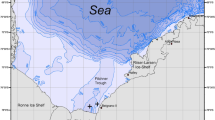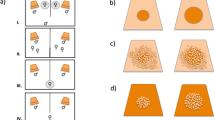Abstract
We documented male and female parental roles of a monogamous fish, the spotted tilapia, Tilapia mariae, in channelized rivers in southern Florida, where this species dominated the fish fauna within 10 years of their introduction. Clearly differentiated parental roles existed between males and females, with females performing nearly all tending of embryos and most tending of free embryos. After young became free-swimming and left the nest, however, males took over primary tending of the school of young while the female patrolled the perimeter of the school and performed nearly all chases directed at predators. Male and female T. mariae also traded off vigilance and feeding, and showed a high degree of intrapair coordination. Experimental removal of one or both parents had major effects on parental behavior and brood survival and integrity. Solitary females took on a parental role intermediate between that of the male and female of a pair. Untended broods were attacked by predators and scattered into aquatic vegetation, and were not observed to reform. Under dense nesting conditions we observed adoption of broods, group rearing of free-swimming young and the presence of non-breeder ‘satellites’ sharing and defending a territory with breeders. This highly complex parental care may have allowed T. mariae to invade fish communities dominated by uniparental centrarchids, as well as allowing them to use disturbed habitats such as channelized rivers that are of poor quality for nesting and rearing offspring.
Similar content being viewed by others
References cited
Altmann, J. 1974. Observational study of behaviour: sampling methods. Behaviour 49: 227–267.
Annett, C.A. 1986. Differential predation on Midas cichlids. Doctoral Dissertation, University of California, Berkeley. 173 pages.
Annett, C.A. 1998. Hunting behavior of Florida largemouth bass, Micropterus salmoides floridanus, in a channelized river. Env. Biol. Fish. 53: 75–87.
Baldaccini, N.E. 1973. An ethological study of reproductive behaviour including the colour patterns of the cichlid fish Tilapia mariae (Boulanger). Monitore Zol. Ital. 7: 247–290.
Balshine-Earn, S. 1995. The costs of parental care in Galille St. Peter's fish, Sarotherodon galilaeus. Anim. Behav. 50: 1–7.
Barlow, G.W. 1984. Patterns of monogamy among teleost fishes. Arch. Gisc. Wiss. 35: 75–123.
Baylis, J.R. 1974. The behavior and ecology of Herotilapia multispinosa (Teleostei, Cichlidae). Z. Tierpsychol. 34: 115–146.
Blumer, L.S. 1982. A bibliography and categorization of bony fishes exhibiting parental care. Zool. J. Linn. Soc. 75: 1–22.
Bowen, S.H. 1982. Feeding, digestion, and growth. Qualitative considerations. pp. 141–156. In: R.S.V. Pullin & R.H. Lowe-McConnell (ed.) The Biology and Culture of Tilapias, ICLARM Conference Proceedings 7, Manila.
Breder, C.M. Jr. & D.E. Rosen. 1966. Modes of reproduction in fishes. The Natural History Press, Garden City. 941 pp.
Clifton, K.E. 1990. The costs and benefits of territory sharing for the Caribbean coral reef fish, Scarus iserti. Behav. Ecol. Sociobiol. 26: 139–147.
Cole, J.E. & J.A. Ward. 1969. The communicative function of pelvic fin-flickering in Etroplus maculatus. Behaviour 35: 176–199.
Courtenay, W.R. & D.A. Hensley. 1979. Range expansion in southern Florida of the introduced spotted tilapia, with comments on its environmental impress. Env. Conserv. 6: 149–151.
Dupuis, H.M.C. & M.H.A. Keenleyside. 1982. Egg-caring behavior of Aeguedens paraguayensis (Pisces, Cichlidae) in relation to predation pressure and spawning substrate. Can. J. Zool. 60: 1794–1799.
Gross, M.R. & R.C. Sargent. 1985. The evolution of male and female parental care in fishes. Amer. Zool. 25: 807–822.
Hulscher-Emeis, T.M. 1993. The variable colour patterns of Tilapia zillii (Cichlidae): integrating ethology, chromatophore regulation and the physiology of stress. Netherlands J. Zool. 42: 525–560.
Itzkowitz, M. 1984. Parental division of labor in a monogamous fish. Behaviour 89: 251–260.
Itzkowitz, M. 1985. Sexual difference in offspring defense in a monogamous cichlid fish. Z. Tierpsychol. 70: 247–255.
Itzkowitz, M. & J. Nyby. 1982. Field observations of parental behavior of the Texas cichlid, Cichlasoma cyanoguttatum. Amer. Midl. Nat. 108: 364–368.
Keenleyside, M.H.A. 1978. Parental care behavior in fishes and birds. pp. 1–19. In: E.S. Reese & F. Lighter (ed.) Contrasts in Behavior, Wiley, New York.
Kuwamura, T., M. Nagoshi & T. Sato. 1989. Female-to-male shift of mouthbrooding in a cichlid fish, Tanganicodus irasacae, with notes on breeding habits of two related species in Lake Tanganyika. Env. Biol. Fish. 24: 187–198.
Lamprecht, J. 1973. Mechanismen des paarzusammenhaltes beim Cichliden Tilapia mariae Boulenger 1899 (Cichlidae, Teleostei). Z. Tierpsychol. 32: 10–62.
Lazarus, J. 1990. The logic of mate desertion. Anim. Behav. 39: 672–684.
Lavery, R.J. & J.D. Kieffer. 1994. Effects of parent and offspring food rations on parental care in the convict cichlid fish (Pisces, Cichlidae). Behaviour 129: 63–77.
Lavery, R.J. & S.G. Reebs. 1994. Effect of mate removal on current and subsequent parental care in the convict cichlid (Pisces: Cichlidae). Ethology 97: 265–277.
Limberger, D. 1983. Pairs and harems in a cichlid fish, Lamprologus brichardi. Z. Tierpsych. 62: 115–144.
Lindstrom, K. & M. Hellstrom. 1993. Male size and parental care in the sand goby, Pomatoschistus minutus. Ethol., Ecol. Evol. 5: 97–106.
MacDonald, D.W. 1988. Running with the fox. Facts on File Press, London. 180 pp.
Marconato, A., A. Bisazza & M. Fabris. 1993. The cost of parental care and egg cannibalism in the river bullhead, Cottus gobio L. (Pisces, Cottidae). Behav. Ecol. Sociobiol. 32: 229–237.
Morris, R. 1987. Time-partitioning of clutch and brood care in herring gulls: a measure of parental quality? Studies in Avian Biology 10: 68–74.
Mrowka, W. 1982. Effects of removal of the mate on the parental care behaviour of the biparental cichlid Aequidens paraguayensis. Anim. Behav. 30: 295–297.
Neil, S. 1984. Field studies of the behavioral ecology and agonistic behavior of Cichlasoma meeki (Pisces, Cichlidae). Env. Biol. Fish 10: 59–68.
Noltie, D.B. & M.H.A. Keenleyside. 1986. Correlates of reproductive success in stream-dwelling male rock bass, Ambloplites rupestris (Centrarchidae). Env. Biol. Fish 17: 61–70.
Perrone, M. & T. Zaret. 1979. Parental care patterns of fishes. Amer. Nat. 113: 351–361.
Pierotti, R. 1980. Spite and altruism in gulls. Amer. Nat. 115: 290–300.
Pierotti, R. 1981. Male and female parental roles in the western gull under different environmental conditions. Auk 98: 532–549.
Pierotti, R. 1987. Behavioral consequences of habitat selection in the herring gull. Studies in Avian Biology 10: 119–128.
Pierotti, R. 1991. Adoption vs. infanticide: an intergenerational conflict. Amer. Nat. 138: 1140–1158.
Rechten, C. 1980. Brood relief behavior of the cichlid fish Etroplus maculatus. Z. Tierpsychol. 52: 77–102.
Ribbink, A.J. 1990. Alternative life-history styles of some African cichlid fishes. Env. Biol. Fish. 28: 87–100.
Rogers, W. 1988. Parental investment and division of labor in the Midas cichlid (Cichlasoma citrinellum). Ethology 79: 126–142.
Rogers, W. 1995. Female choice predicts the best father in a biparental fish, the Midas cichlid (Cichlasoma citrinellum). Ethology 100: 230–241.
Sabat, A.M. 1994a. Costs and benefits of parental effort in a brood-guarding fish (Ambloplites rupestris, Centrarchidae). Behav. Ecol. 5: 195–210.
Sabat, A.M. 1994b. Mating success in brood-guarding male rock bass, Ambloplites rupestris: the effect of body size. Env. Biol. Fish 39: 411–415.
Schwanck, E. 1987. Reproductive behaviour of a monogamous cichlid fish, Tilapia mariae. Ph.D. Dissertation, University of Stockholm, Stockholm. 130 pp.
Schwanck, E.J. 1989. Parental care of Tilapia mariae in the field and in aquaria. Env. Biol. Fish 24: 251–265.
Taborsky, M. 1984. Broodcare helpers in the cichlid fish Lamprologous brichardi: their costs and benefits. Anim. Behav. 32: 1236–1252.
Taborsky, M. & D. Limberger. 1981: Helpers in fish. Behav. Ecol. Sociobiol. 8: 143–145.
Townsend, T.J. & R.J. Wooten. 1985. Variation in the mating system of a biparental cichlid fish, Cichlasoma panamense. Behaviour 95: 181–197.
Trivers, R.L. 1972. Parental investment and sexual selection. pp. 136–179. In: B. Campbell (ed.) Sexual Selection and the Descent of Man, Aldine Press, Chicago.
Ward, J.A. & J.I. Samarkoon. 1981. Reproductive tactics of the Asian cichlids of the genus Etroplus in Sri Lanka. Env. Biol. Fish 6: 95–103.
Ward, J.A. & R.L. Wyman. 1977. Ethology and ecology of cichlids of the genus Etroplus in Sri Lanka. Env. Biol. Fish 2: 137–145.
Wisenden, B., T.L. Lanfranconi-Izawa & M.H.A. Keenleyside. 1995. Fin digging and leaf lifting by the convict cichlid, Cichlasoma nigrofasciatum: examples of parental food provisioning. Anim. Behav. 49: 623–631.
Yanagisawa, Y. 1985. Parental strategy of the cichlid fish Perissodus microlepis, with particular reference to intraspecific brood \lsfarming out\rs. Env. Biol. Fish. 12: 241–249.
Zoran, M. & J. Ward. 1983. Parental egg care behavior and fanning activity for the orange chromide, Etroplus maculatus. Env. Biol. Fish 8: 301–310.
Author information
Authors and Affiliations
Rights and permissions
About this article
Cite this article
Annett, C.A., Pierotti, R. & Baylis, J.R. Male and Female Parental Roles in the Monogamous Cichlid, Tilapia mariae, Introduced in Florida. Environmental Biology of Fishes 54, 283–293 (1999). https://doi.org/10.1023/A:1007567028017
Issue Date:
DOI: https://doi.org/10.1023/A:1007567028017




